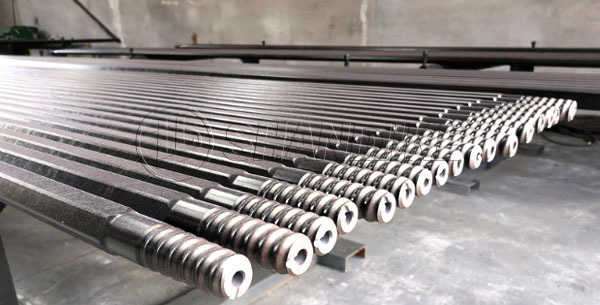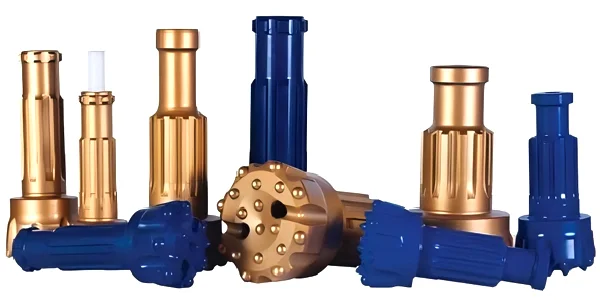Maintenance and upkeep of down the hole drill bits and hammer


High wind pressure impactor is a type of rock drilling tool, but unlike other rock drilling tools, it always stays at the bottom of the hole during the drilling process, and the piston directly impacts the drill bit. Compressed gas enters the impactor through the drill rod and is then discharged from the drill bit, and the exhaust gas is used to discharge slag. The rotary motion of the impactor is provided by the rotary head of the drilling rig, and the axial thrust is provided by the propulsion mechanism of the drilling rig, which is transmitted to the impactor through the drill rod.
2、 Structural principle
The down the hole impactor is composed of a piston, an inner cylinder, a valve seat, a check valve, and drill bit accessories installed in a slender outer cylinder. The upper end of the outer cylinder is equipped with an upper joint with a plate handle and a connecting thread, and the lower end is equipped with a threaded clamping sleeve. The clamping sleeve is mainly used to transmit thrust and rotary motion to the drill bit, and the clamping ring controls the axial movement of the drill bit. The check valve is used to prevent debris such as rock slag from entering the impactor when the supply of compressed air is stopped. During the drilling process, the drill bit is pushed into the impactor and pressed against the clamping sleeve. At this time, the piston directly impacts the drill bit into rock drilling. When the drill bit is lifted off the bottom of the hole, it begins to forcefully blow and discharge slag.
3、 Precautions for use and operation
- Ensure reliable lubrication
The lubrication of the impactor is achieved through the oil injector on the drilling rig, so it is necessary to ensure that the oil injector is filled with lubricating oil before the start of each shift, and there is still residual oil before the next shift, - Install the impactor before the drill rod, operate the impact air valve to exhaust and remove debris from the drill rod, and check if there is lubricating oil on the drill rod. After connecting the impactor, check if there is an oil film on the drill bit spline. If there is obvious no oil or the oil level is too high, adjust the oil injector system.
When the impactor starts drilling, the push air valve should be operated to make the impactor move forward, press against the ground, and open the impact air valve to make the impactor work. At this time, attention should be paid not to make the impactor rotate, otherwise it is impossible to stabilize the drill. When a small pit is formed by the impact and the drill is stabilized, then open the rotary air valve to make the impactor work normally. - During the work process, regularly check the air compressor tachometer and pressure gauge. If the drilling speed drops rapidly and the pressure increases, it indicates that there is a malfunction in the drilling machine. If the hole wall collapses or mud hoops are formed in the hole, timely measures should be taken to eliminate them.
- During the drilling process, always keep the hole free of rock debris. If necessary, perform a strong blow to clean the hole by lifting the impactor 150mm away from the bottom of the hole. At this point, the impactor stops impacting and all compressed air is discharged through the center hole of the impactor.
If the drill bit falls off the column or debris falls into the hole, it should be promptly sucked out with a magnet. - Regularly grind the drill bit teeth, and the height of the teeth after grinding should be 9-9.6mm.
- When replacing the drill bit, attention should be paid to the diameter change. If the worn hole of the drill bit has not been drilled, it is impossible to replace the drill bit with a new one to avoid “sticking the drill bit”.
Efficient drilling and improving the service life of drill bits depend on the appropriate combination of axial pressure and rotational speed. Various rock layers will affect the rotational speed and axial pressure, and it is advisable to avoid rebound during the operation of the impactor. The rotational speed can be adjusted according to the particle size of the rock slag. - It is strictly prohibited to reverse the impactor and drill rod inside the hole to prevent the impactor from falling into the hole.
- When drilling a downward hole, do not immediately stop supplying gas to the impactor when drilling stops. Instead, lift the drill for strong blowing until there is no more rock debris or powder discharged from the hole before stopping the air flow. Then, lower the drilling tool and stop rotating.
4、 Repair and maintenance
Under normal rock drilling conditions, the impactor should be inspected, cleaned, and reassembled every 200 hours of operation. When drilling water holes or using mud to remove slag, it should be done every 100 hours by a dedicated person in the repair workshop.
5、 Cleaning, testing, and repair - Thoroughly clean all removed parts with cleaning agent and blow dry with compressed air.
- Inspect all parts of each component, and if there are any bumps or scratches, use a file, scraper, or fine oilstone to polish and repair them completely. (Piston parts can be stuck on the lathe for grinding) If there are thermal cracks or damage, they should be replaced,
- Measure the large outer circle of the piston and the inner diameter of the cylinder with a micrometer and an inner diameter gauge. If the fit clearance is too large, replace the piston or cylinder with a new one.
- Check the wear of the card sleeve, and replace it with a new one when its outer circumference is worn to less than the outer diameter of the outer tube.
- Check the wear of the keyway of the card sleeve. If the outer circle is worn to less than the outer diameter of the outer tube, it should be replaced with a new one. 5mm should replace the brazing sleeve.
- Apply lubricating oil to all parts of the repaired parts and all parts to be assembled.
6、 Assembly of impactor - Stand the lower end of the outer tube upwards on the ground, insert the small head of the liner downwards into the outer tube, and strike it in place with a copper rod.
- Place the drill bit head down on the ground, apply a layer of butter to the inner thread of the outer pipe, insert the large outer circle of the drill bit into the drill bit, and insert the O-ring into the small outer circle of the drill bit. Connect the drill bit, drill bit sleeve, and O-ring together and screw them into the outer pipe.
- Place the outer tube containing the drill bit on the workbench, drive the valve seat into the inner cylinder with a copper rod, insert the piston into the cylinder and push it into the outer tube from the upper end of the outer tube, and strike it in place with a copper rod.
- Insert the spring and check valve, and check if the check valve moves freely.
- Apply a layer of butter to the internal thread on the upper end of the outer tube, and screw the rear joint into the outer tube.
- Use a long barrel to check if the piston can move freely.
7、 Common troubleshooting methods
Fault 1: Insufficient lubricating oil or failure to cause premature wear or damage.
Reason: The lubricating oil cannot reach the impact structure of the impactor.
Exclusion method: Check the lubrication device, adjust the oil injector, and increase the oil injection volume. - The clearance between the piston and the inner and outer cylinders, as well as between the piston and the valve seat, is too large.
- The impactor is blocked by dirt.
- The piston or drill bit tail is broken.
Exclusion method: - Check the air pressure and ensure that the air path is unobstructed. Is the check valve stuck.
- Disassemble the impactor, check for wear, and replace worn parts. (For the impactor to function properly, please use genuine accessories from our company.)
- Disassemble the impactor and clean all internal components inside the impactor.
- Disassemble the impactor and replace the piston or drill bit. (For the good operation of the impactor, please choose genuine accessories from our company)
Fault 3: The drill bit and drill sleeve come off
Reason: The impactor did not rotate to the right during operation.
Exclusion method: Hook up the detached parts and ensure a right turn when drilling or lifting.



